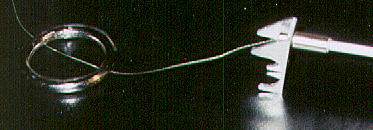|
|
 Three guitar string tighteners were mounted in a thin wall square aluminum tube. The turn key facing to the right adjusts roll, the key coming out of the screen adjusts pitch, and the vertical key will perhaps someday adjust yaw.
Three guitar string tighteners were mounted in a thin wall square aluminum tube. The turn key facing to the right adjusts roll, the key coming out of the screen adjusts pitch, and the vertical key will perhaps someday adjust yaw.
|
 Thirty pound woven fish line is used to transfer the force to the bungee cords. It is tied to the guitar string tighteners and threaded through a small soft aluminum tube just like a bicycle brake cable. Bicycle cable housing ends and tubing spacers are used on the ends of the aluminum tube so that the tube can take the reaction forces. A bit of "U" channel aluminum was cut and formed so that the outer end could be terminated at one of the cage tubular cross members. The fish line was tied to a ring large enough so that the bungee cord ends could pass through the center of the ring.
Thirty pound woven fish line is used to transfer the force to the bungee cords. It is tied to the guitar string tighteners and threaded through a small soft aluminum tube just like a bicycle brake cable. Bicycle cable housing ends and tubing spacers are used on the ends of the aluminum tube so that the tube can take the reaction forces. A bit of "U" channel aluminum was cut and formed so that the outer end could be terminated at one of the cage tubular cross members. The fish line was tied to a ring large enough so that the bungee cord ends could pass through the center of the ring.
 Above is the whole assembly before it was mounted in the FireFly, and below is the installed system. The adjuster assembly is mounted on the left hand side of the fuselage below the original rear seat cross tube. This position is good for me, because I can drop my hand straight down to reach the keys. You rotate the top of the key in the direction you would like the plane to go for aileron and elevator.  The bungee cords on the right go to the upper elevator control horn. The tube and fish line that goes to the rear connects to the bungee cords on the aileron push rod. This whole assembly weighs a few ounces.
The bungee cords on the right go to the upper elevator control horn. The tube and fish line that goes to the rear connects to the bungee cords on the aileron push rod. This whole assembly weighs a few ounces.
The other advantage to this system is that if a trim system component fails, there is no possibility of aileron or elevator flutter as there might be if an adjustable trimming surface mounted to the elevator or aileron surface be came disconnected. The major disadvantage is that one just maintain side pressure on the stick to center the ailerons below cruise speed to keep the wings level. The lower the speed the greater the force required, but this force is quite low. |